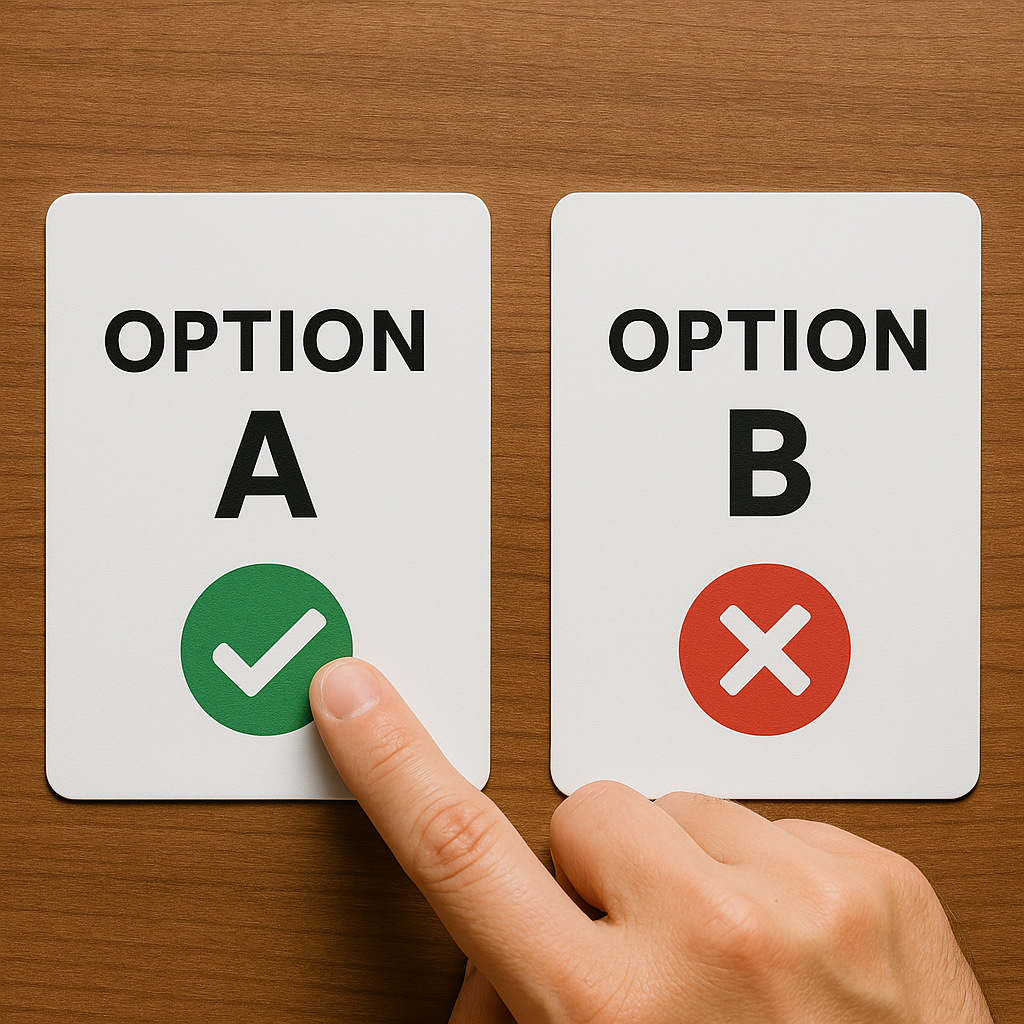2.4.2025
Decision-making in teams can be tricky—even with great talent in the room. Differing opinions, hidden biases, and group dynamics can easily derail discussions and leave the best ideas on the table. That’s where pairwise comparison or voting enters the picture. By providing a structured yet flexible way to evaluate options, it helps teams make smarter decisions while avoiding the common pitfalls of bias and groupthink.
This guide walks team managers, leaders, and collaborators through everything you need to know about pairwise voting. You’ll learn what it is, how it works, and why it’s so effective at driving better results for teams.
What is Bias and Groupthink?
Before we dive into the mechanics of pairwise comparison, let’s address two key challenges in decision-making.
Bias in Decision-Making
Bias occurs when decisions are swayed by subjective opinions, preconceived notions, or information silos. These biases might include favoritism toward a specific team member’s idea, overvaluing vocal individuals over quieter contributors, or even adhering to traditional methods without considering innovation. The result? Great ideas might be overlooked or dismissed.
Daniel Kahneman, Nobel laureate and author of Thinking, Fast and Slow, spent years exploring how we make decisions. Working with his research partner Amos Tversky, he uncovered the mental shortcuts — or cognitive biases — that influence the choices we make every day. Their work laid the foundation for behavioral economics, making it easier to understand why we think and act the way we do.
Here’s a concise list of some key biases discussed in the book and their potential impacts:
- Anchoring Bias: Ever notice how the first piece of information you hear can shape your decisions? That’s anchoring bias. For example, an initial price can influence how you negotiate—sometimes more than it should.
- Availability Heuristic: We tend to overestimate how likely something is based on how easily examples come to mind. For instance, you might fear plane crashes more than car accidents just because they get more media coverage.
- Conjunction Fallacy: This happens when we assume that specific conditions are more likely than general ones. For example, a person reads that there’s a 30% chance of rain and a 40% chance of rain and strong winds. They believe the second forecast is more likely because it feels more specific — even though it’s statistically less probable (it’s a subset of the first).
- Optimism and Loss Aversion: Losing feels worse than winning feels good. This can make us overly cautious, like avoiding investments or opportunities because we’re more afraid of losing than excited about gaining. Imagine this scenario: I offer you a simple bet. Flip a coin. If it lands on heads, you win €100. If it lands on tails, you lose €100. Sounds fair, right? Statistically, it is—a 50-50 chance. Yet most people would decline. Why? Because the pain of losing €100 feels far more intense than the joy of winning the same amount.
- Framing Effect: How something is presented can change the way you feel about it. For example, you might feel more positive about a treatment with a “90% survival rate” than one with a “10% mortality rate,” even though they mean the same thing.
- Sunk Cost Fallacy: This bias shows up when you stick with something just because you’ve already invested time, money, or effort, even if it no longer makes sense. Think of staying in a failing project just because you’ve already put so much into it.
Understanding these biases can help you make better, more informed decisions—without letting your brain’s shortcuts get in the way!
Groupthink in Teams
Groupthink, on the other hand, happens when teams prioritize consensus over critical thinking. A desire to “keep the peace” or avoid confrontation leads to uniformity, even when the decisions might not serve the team’s goals. This can derail creativity, stifle innovation, and result in decisions that appeal to everyone but satisfy no one.
Abilene’s paradox is a phenomenon similar to groupthink, but not quite the same. It highlights how groups can make decisions that no one actually supports, often due to a fear of conflict or miscommunication. This can be detrimental to the team’s progress and overall success.
To avoid falling into the traps of groupthink and Abilene’s paradox, it is important for teams to actively encourage diverse perspectives and open communication. This means creating a safe space where individuals feel comfortable speaking up and challenging ideas, without fear of judgement or retribution.
One effective way to promote diverse thinking is through brainstorming sessions. By encouraging all team members to share their ideas without criticism, teams can explore different options and come up with more innovative solutions. It also allows for individuals who may not typically speak up in group settings to have their voices heard.
Additionally, leaders should strive to foster a culture that values critical thinking over consensus.
Fortunately, techniques like pairwise comparison can break through these barriers to encourage more balanced, data-driven decisions.
What is Pairwise Comparison?
Pairwise comparison, also known as pairwise voting, is a systematic method for evaluating multiple options by comparing them two at a time. Instead of trying to rank or choose from all the available options at once, decision-makers compare them in pairs, which is less overwhelming and more objective.
Here’s a simple example:
Imagine your team is debating which feature to prioritize for your next product update. Instead of everyone throwing out opinions, pairwise voting lets your team compare two features at a time—say Feature A vs. Feature B—and vote for the stronger option. The same process is repeated for every combination (e.g., Feature A vs. Feature C, Feature B vs. Feature C) until you have a clear ranking or winner.
Pairwise comparison works for decisions big and small, like prioritizing project goals, allocating resources, or selecting the perfect venue for your next team event. It eliminates the chaos of group debates and replaces it with clear, measurable insights.
Benefits of Pairwise Comparison
Implementing pairwise voting in teams can drive powerful results. Here are four key benefits this method brings to the table:
1. Reduces Bias
Since participants evaluate options objectively in pairs, the process limits the influence of biases. No single person’s idea overshadows the rest, and all options are given a fair comparison.
2. Breaks Down Complex Decisions
Looking at dozens of choices can be overwhelming. Pairwise voting simplifies decision-making by breaking it down into bite-sized comparisons. This structured approach makes even the most complex decisions manageable.
3. Prevents Groupthink
Pairwise voting encourages independent thinking. Each person’s vote is based on individual judgment, reducing the pressure to conform to dominant opinions or the loudest voices in the room.
4. Promotes Equal Participation
Because every team member has the same opportunity to vote, pairwise voting ensures that quieter or less outspoken contributors are equally heard in the decision-making process.
5. Guarantees Transparent Outcomes
Pairwise voting creates clear and traceable results. Every decision made through this process can be reviewed step-by-step, providing transparency and accountability for the team.
How to Implement Pairwise Comparison Effectively
To make the most of pairwise voting, follow these best practices:
1. Define Clear Criteria
Before starting, agree on what criteria you’ll use to evaluate the options. Is it cost-effectiveness? Impact on the business? Ease of implementation? Clear criteria ensure everyone focuses on the same goals.
2. Use the Right Tools
Manually comparing pairs on a spreadsheet can work for small decisions, but tools like Noni streamline the process for larger teams. Noni helps teams gather, submit, and vote on options while automatically calculating results.
3. Set Voting Guidelines
Establish ground rules so everyone understands how the process works. For example, should participants focus on their personal preferences or what’s best for the team overall? Clarity upfront ensures consistency.
4. Review Data Together
Once the votes are in, spend time as a team reviewing the results and how they align with your goals. Openly discuss any discrepancies to make sure the process reflects real priorities.
5. Apply It Often
The more your team uses pairwise voting, the easier it becomes. Starting with smaller, low-stakes decisions helps your team get comfortable with the process before integrating it into bigger projects.
How Noni Applies Pairwise Comparison
With Noni, pairwise voting becomes a powerful tool for collaborative decision-making. Noni enables users to suggest a variety of options and facilitates meaningful discussions before voting begins, allowing everyone to share their perspectives. By using Noni, you can ensure every voice is heard and decisions are made with clarity and inclusivity.

Empower Your Team with Smarter Decisions
Pairwise voting is a game-changer for decision-making. By eliminating bias, simplifying complex choices, and inviting diverse input, it empowers teams to think critically and collaboratively. It encourages fairness, alignment, and clarity in every step.
Want to take the stress out of team decisions and maximize collaboration? Try Noni’s decision-making tools to supercharge your next team meeting. With pairwise voting built right into the platform, you’ll streamline discussions, improve outcomes, and ensure that every voice matters.




